Why this resume works
- Quantifies accomplishments: Measurable accomplishments like increasing efficiency by 20% and cutting costs by $15,000 showcase the applicant’s tangible impact on architectural projects.
- Uses action-oriented language: Using strong action verbs such as “led,” “coordinated,” and “revised” conveys initiative and effectiveness.
- Illustrates problem-solving ability: Revising designs to cut project costs by $15,000 is a prime example of the applicant’s problem-solving skills, showcasing critical thinking and innovation.
More Architect Resume Examples
Browse our architect resume examples to discover how to showcase your design expertise, technical skills, and project achievements. These architecture resume samples will help you create a compelling resume that highlights your architectural experience effectively.
Entry-Level Architect
Why this resume works
- Centers on academic background: The education section impresses with degrees from MIT and UC Berkeley, showcasing a solid academic foundation important for an early career in architecture.
- Effective use of keywords: Keywords like “project management” and “sustainable practices” are integrated throughout the resume, ensuring it effectively navigates applicant tracking systems (ATS).
- Puts skills at the forefront: By prioritizing skills such as building design and CAD software, the resume uses a skills-based resume format, ideal for emerging architects.
Mid-Level Architect
Why this resume works
- Points to measurable outcomes: By showcasing design innovations boosting revenue by $500K and cutting waste by 30%, the applicant effectively communicates their ability to achieve significant measurable outcomes.
- Includes a mix of soft and hard skills: Balancing technical expertise in AutoCAD and Revit with interpersonal skills reflects a well-rounded skill set, improving collaboration and project success.
- Demonstrates language abilities: Beginner Spanish and intermediate French highlight language skills essential for cross-cultural communication and international projects.
Experienced Architect
Why this resume works
- Showcases impressive accomplishments: By showcasing achievements like a 25% increase in portfolio value, the applicant’s accomplishments reveal an impressive impact on business growth.
- Focuses on work history: The applicant uses a chronological resume format to effectively highlight extensive experience, detailing roles from junior architect to key leadership positions.
- Emphasizes leadership skills: Leading sustainable design practices and managing multimillion-dollar portfolios shows the applicant’s leadership skills in guiding teams toward successful project outcomes.
Architect Resume Template (Text Version)
Jin Nguyen
Parkview, MO 64162
(555)555-5555
Jin.Nguyen@example.com
Professional Summary
Innovative architect with a proven track record in sustainable design and project management. Expertise in improving project efficiency and reducing costs through strategic planning. Skilled in leading cross-functional teams to meet project goals.
Work History
Architect
Skyline Designs – Parkview, MO
June 2023 – June 2025
- Led design projects increasing efficiency by 20%
- Coordinated with contractors to improve timelines by 10%
- Revised designs, cutting project costs by ,000
Design Architect
Urban Sphere Architects – Parkview, MO
September 2020 – May 2023
- Developed 15 innovative urban designs
- Enhanced project sustainability by 30%
- Managed a team reducing errors by 25%
Junior Architect
GreenField Construction – St. Louis, MO
June 2019 – August 2020
- Assisted in drafting for over 20 projects
- Improved drafting accuracy by 15%
- Collaborated with senior architects to streamline designs
Certifications
- Certified Architectural Professional – National Council of Architectural Registration Boards
- LEED Green Associate – U.S. Green Building Council
Education
Master of Architecture Architecture
University of California, Berkeley Berkeley, California
May 2019
Bachelor of Science Architectural Studies
University of Southern California Los Angeles, California
May 2017
Languages
- Spanish – Beginner (A1)
- French – Intermediate (B1)
- German – Beginner (A1)
Skills
- Architectural Design
- Project Management
- Sustainable Design
- 3D Modeling
- Building Codes
- AutoCAD
- Revit
- Team Leadership
Related Resume Guides
Advice for Writing Your Architect Resume
Discover how to craft a standout resume for an architect role that highlights your design expertise and creative vision. Explore our tips on how to write a resume and learn how to tailor your experience and skills to land your dream architectural job.
Highlight relevant technical skills
Technical skills are essential for an architect because they show your ability to design and manage projects. Creating a dedicated skills section on your resume helps highlight what you can do right away. You can also mention these skills in your work experience section. This way, hiring managers can see how you’ve used these skills in real projects.
Common technical skills for architects include using software like AutoCAD, Revit, and SketchUp for creating designs and plans. Knowledge of building codes and regulations is also key since it ensures that your designs are safe and legal. Other useful skills include project management tools like Microsoft Project or Primavera, which help keep everything on track.
Example of a technical skills section
- Architecture design software (Revit, AutoCAD)
- Building information modeling (BIM)
- Sustainable building practices
- Structural analysis tools
- 3D rendering and visualization
- Project management software (Primavera, Microsoft Project)
- Construction documentation processes
- Urban planning and design principles
You can use our Resume Builder to easily create a resume that highlights soft skills like teamwork, communication, and adaptability.
Quantify your accomplishments
Quantifying accomplishments on a resume makes it more compelling by showing what you can achieve, not just what you do. For an architect, turning duties into achievements with numbers gives your work experience section a powerful impact.
Every job entry should include your job title, employer name, location, and employment dates. But more importantly, focus on measurable results like how much you improved design efficiency or reduced project costs.
Using action verbs paired with metrics creates a results-driven resume that stands out. For example, instead of saying “worked on building projects,” say “designed 10+ residential buildings resulting in 20% cost savings.” This approach helps hiring managers quickly see the value you bring to their team and understand your skills better.
Incorporating these strategies means an architect’s resume conveys clear success stories through numbers and action-oriented language. This makes it easier for potential employers to envision your contributions to their projects. Quantified accomplishments highlight your ability to make a real difference in any role you take on.
5 architect work history bullet points
- Led the design and execution of a $5 million residential project, completing it 3 months ahead of schedule and under budget by 10%.
- Developed sustainable architectural solutions that reduced energy consumption by 25% in commercial buildings.
- Collaborated with multidisciplinary teams to redesign urban spaces, increasing pedestrian traffic by 40%.
- Managed a portfolio of over 20 projects annually, ensuring compliance with local building codes and client specifications.
- Used advanced BIM software to streamline workflows, cutting project delivery time by 15%.
Check out these professional resume examples to see how to best show off your skills and experience.
Write a powerful professional summary
A professional summary is like the opening line of a book; it’s meant to grab the hiring manager’s attention right from the start. You can choose between a summary and an objective, depending on your career stage and goals.
For experienced architects, a professional summary showcases your experience, skills, and achievements in just a few sentences. It highlights your professional identity and the value you bring to potential employers.
On the other hand, resume objectives are statements about what you hope to achieve in your career. They’re best for entry-level job seekers, those changing careers, or individuals with gaps in their work history. While a summary focuses on “what I’ve accomplished,” an objective looks at “what I aim to contribute.”
Now that you understand the difference between summaries and objectives, we’ll dive into examples tailored for various industries and levels of experience.
Architect resume summary examples
Entry-level
Recent architecture graduate with a Bachelor of Architecture degree from a NAAB-accredited program. Skilled in architectural drafting, 3D modeling, and sustainable design principles. Proficient in AutoCAD, Revit, and SketchUp. Eager to contribute to innovative projects and collaborate with experienced architects to create functional and aesthetically pleasing structures.
Mid-career
Architect with over seven years of experience in residential and commercial design. Expertise in project management, client liaison, and construction documentation. Proven track record of delivering high-quality designs on time and within budget. Licensed architect with LEED accreditation, known for creative problem-solving and strong interpersonal skills.
Experienced
Seasoned architect specializing in large-scale urban development projects. Over 15 years of experience leading multidisciplinary teams through all phases of design and construction. Expert in sustainable building practices and advanced BIM technologies. Recognized for transforming client visions into award-winning architectural landmarks while ensuring regulatory compliance and cost-effective solutions.
Architect resume objective examples
Recent graduate
Detail-oriented recent architecture graduate eager to apply academic knowledge and design skills in an entry-level architect role. Passionate about sustainable design and committed to contributing innovative solutions within a collaborative team environment.
Career changer
Creative professional transitioning into architecture, bringing a strong background in project management and visual arts. Excited to leverage transferable skills and newly acquired architectural training to support innovative design projects and improve built environments.
Entry-level with internship experience
Ambitious entry-level architect with hands-on experience from internships in residential and commercial projects seeking to join a forward-thinking firm. Driven to contribute fresh perspectives on design challenges while growing expertise in urban planning and green building practices.
Use a polished and professional resume format that lets your skills and experience stand out.
Showcase your credentials
Listing certifications, licenses, and specialized training is important for architects because it shows their expertise and skills in technical fields. These credentials prove that an architect has the knowledge needed to design safe and efficient structures.
A dedicated certifications section on your resume helps employers easily find these qualifications. This section can be placed near the education section to highlight both your formal schooling and additional training. Here are a few examples:
- Architect Registration Examination (ARE)
- NCARB Certificate
- LEED Accredited Professional (LEED AP)
- WELL Accredited Professional (WELL AP)
- Certified Passive House Designer/Consultant
- Project Management Professional (PMP)
- Autodesk Certified Professional
These certifications add value by proving the ability to work with cloud solutions, network security, and other technical areas.
Example of a certifications section
Licensed Architect
Issued by: National Council of Architectural Registration Boards (NCARB)
Issued 2020
LEED Accredited Professional (LEED AP)
Issued by: U.S. Green Building Council (USGBC)
Expires 2025
Certified BIM Manager
Issued by: BuildingSMART International
Issued 2021
WELL Accredited Professional (WELL AP)
Issued by: International WELL Building Institute (IWBI)
Expires 2024
AutoCAD Civil 3D Certification
Issued by: Autodesk
Issued 2019
Choose a resume template that’s simple and tidy, using clear section titles and readable fonts. Avoid flashy designs or fancy fonts to let your skills and experience stand out.
Salary Insights for Architects
Knowing what different careers pay can guide smart decisions about your career direction and where you might want to live. Having access to wage and job outlook data can help you plan with confidence.
Top 10 highest-paying states for architects
Architects earn varying salaries across the United States, with a national average of $108,200. The table below highlights the states where architects command the highest compensation.
Our salary information comes from the U.S. Bureau of Labor Statistics’ Occupational Employment and Wage Statistics survey. This official government data provides the most comprehensive and reliable salary information for writers across all 50 states and the District of Columbia. The figures presented here reflect the May 2025 dataset, which is the most recent available as of this publication.
| State | Average Salary |
|---|---|
| New York | $144,520 |
| Louisiana | $144,810 |
| California | $130,200 |
| Puerto Rico | $125,950 |
| Pennsylvania | $122,080 |
| Connecticut | $122,980 |
| Maryland | $114,540 |
| Florida | $113,730 |
| Rhode Island | $111,790 |
| Indiana | $106,280 |
FAQ
Do I need to include a cover letter with my architect resume?
Yes, adding a cover letter to your architect resume is key for creating a strong impression. A cover letter lets you highlight your passion for architecture and explain why you’re excited about that specific firm or project.
For example, if the firm is known for sustainable design or innovative residential projects, use the cover letter to talk about your related experience and enthusiasm in those areas. You can use our Cover Letter Generator online to help craft a compelling letter, whether starting from scratch or improving your current draft.
Additionally, reviewing cover letter examples can provide inspiration and guidance tailored specifically to architecture roles at various career stages.
How long should an architect’s resume be?
For an architect, a one-page resume is typically enough if you’re early in your career, focusing on key skills like design software skills and relevant project experience.
As you gain more experience, a two-page resume can be fitting to capture extensive project portfolios or specialized certifications.
Make sure every detail counts; highlight projects that showcase your creativity, problem-solving abilities, and leadership in architectural design. Tailor each section to reflect roles that match the job you’re aiming for.
Explore our guide on how long a resume should be for examples and tips on determining the ideal length for your career stage.
How do you write an architect resume with no experience?
If you have no formal experience as an architect, focus your resume on the skills and education that highlight your potential in the field. Here are some strategies to consider when crafting your resume with no experience:
- Emphasize your education: Start with your architecture degree, including the institution, graduation date, and any honors or relevant coursework. If you’ve completed projects during your studies, such as design studios or thesis work, briefly describe them.
- Showcase software skill: Highlight any architectural software you’re skilled in, like AutoCAD, Revit, SketchUp, or Adobe Creative Suite. These tools are important in architecture and will demonstrate technical readiness to potential employers.
- Include internships and volunteer work: Even if unpaid, list any internships or volunteer experiences related to architecture or design. Detail the tasks you performed and skills you developed that align with architectural practices.
- Highlight transferable skills: Mention skills that are valuable in architecture, such as problem-solving abilities, creativity in design solutions, attention to detail, and communication skills.
Consider using a functional resume format to better present your strengths, and check out online resources for additional tips on creating impactful resumes without direct experience.
Rate this article
Architect
Additional Resources
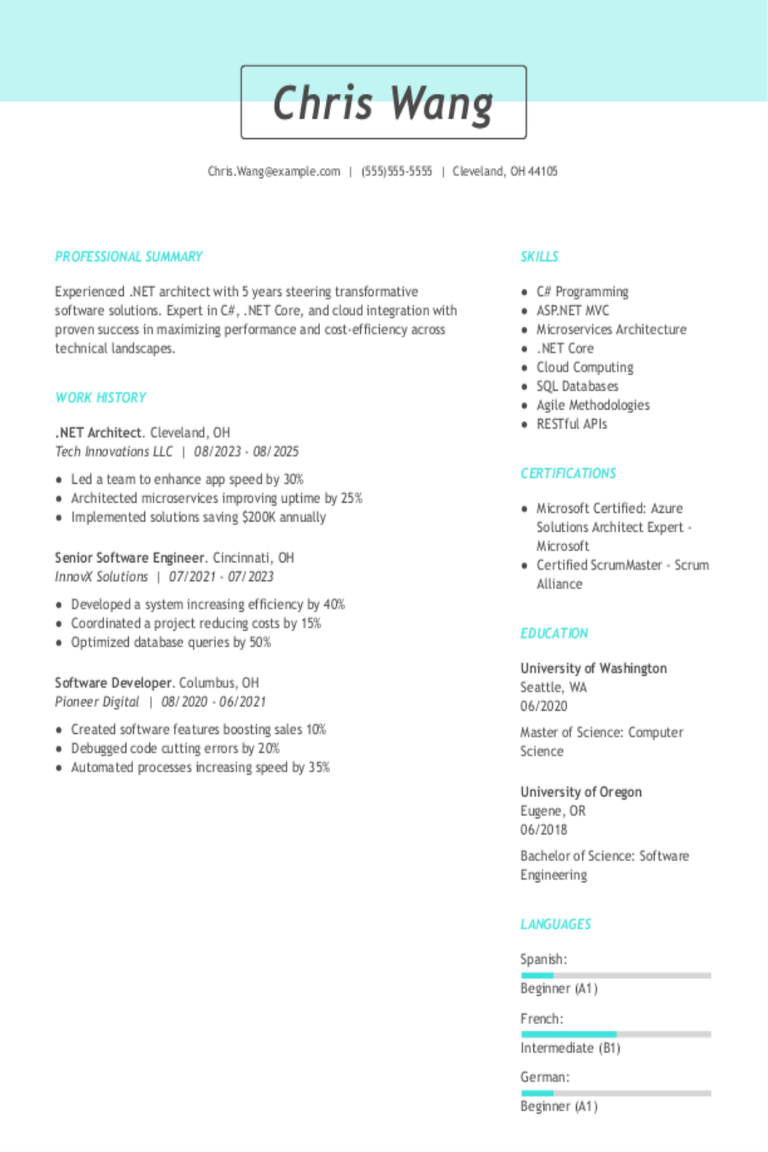
.NET Architect Resume Examples & Templates for 2025
Explore .NET architect resume examples that showcase design skills and problem-solving abilities. Discover tips to highlight your experience with software development and teamwork to impress hiring managers and win more
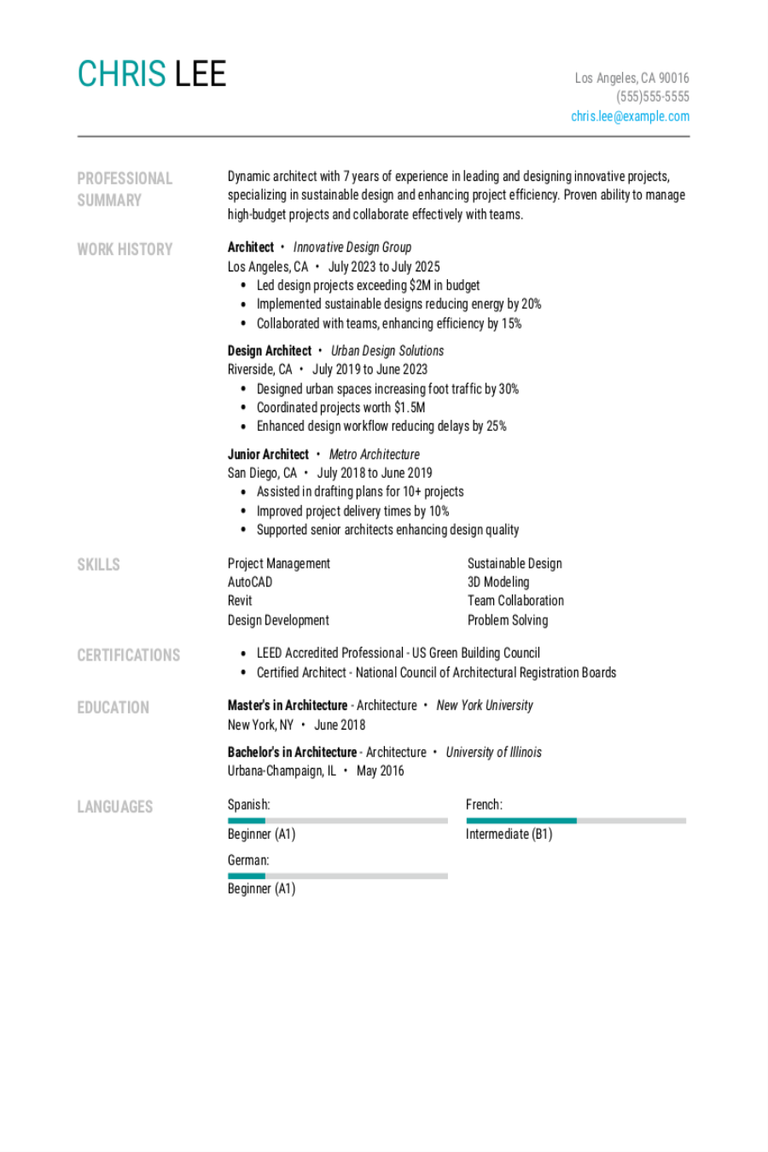
Architecture Resume Examples & Templates for 2025
Explore architecture resume examples and tips to learn how to showcase your creativity and experience designing buildings, creating plans, and working with teams.Build my resumeImport existing resumeCustomize this templateWhy
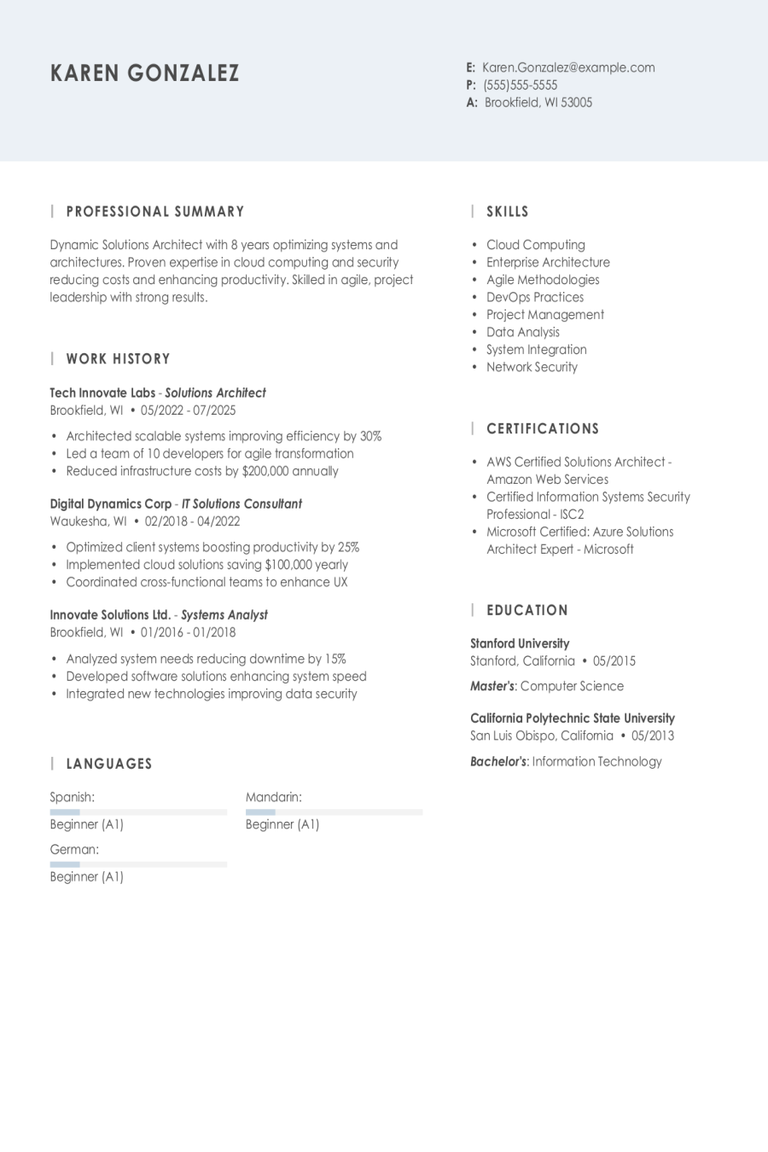
Solutions Architect Resume Examples & Templates for 2025
Your solutions architect resume needs to show how you design systems, work with clients, and solve tech problems. Use our resume examples and tips to help you learn how to
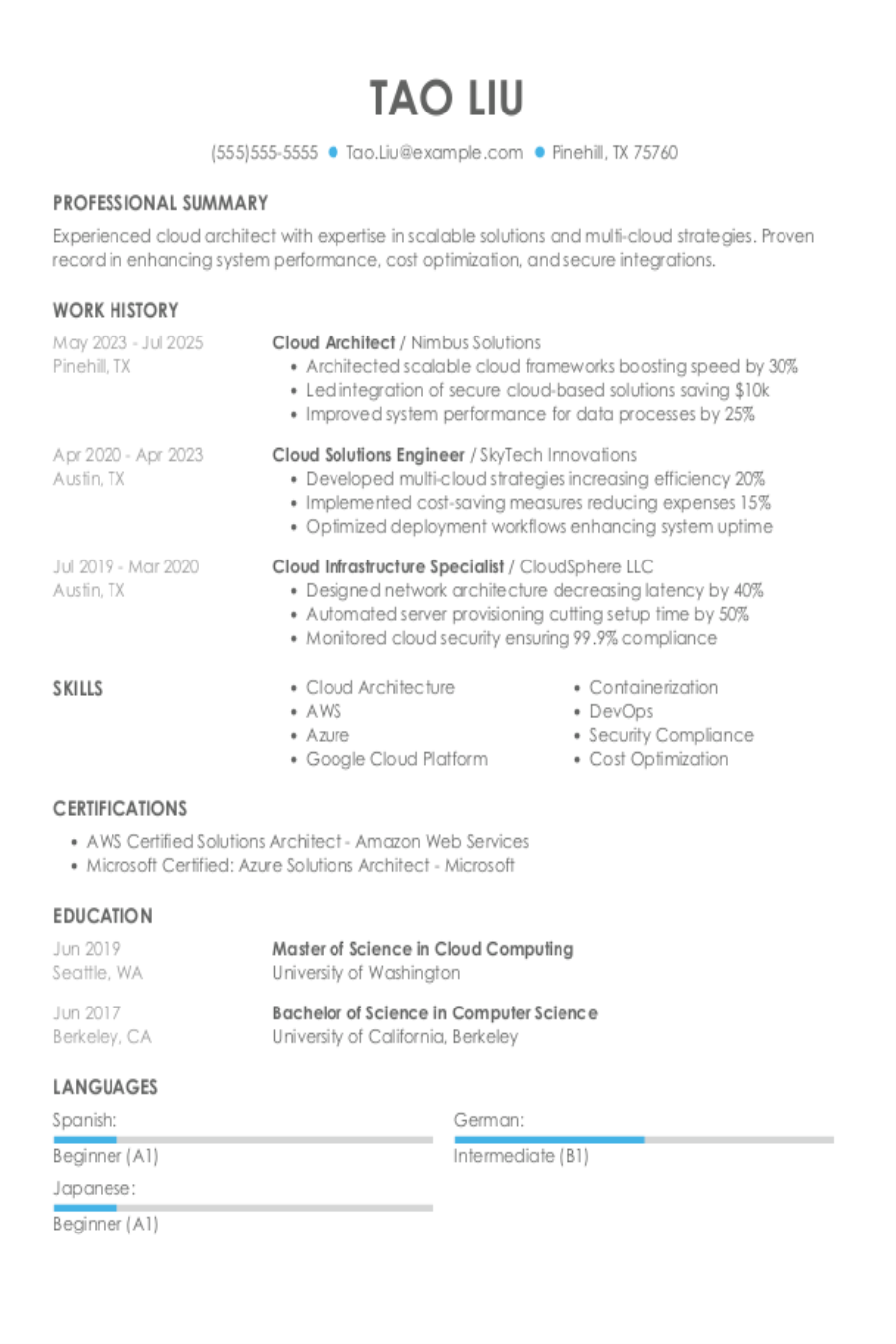
Cloud Architect Resume Examples & Templates for 2025
These cloud architect resume examples and tips will guide you to create a resume that highlights your experience with cloud platforms and solutions.Build my resumeImport existing resumeCustomize this templateWhy this
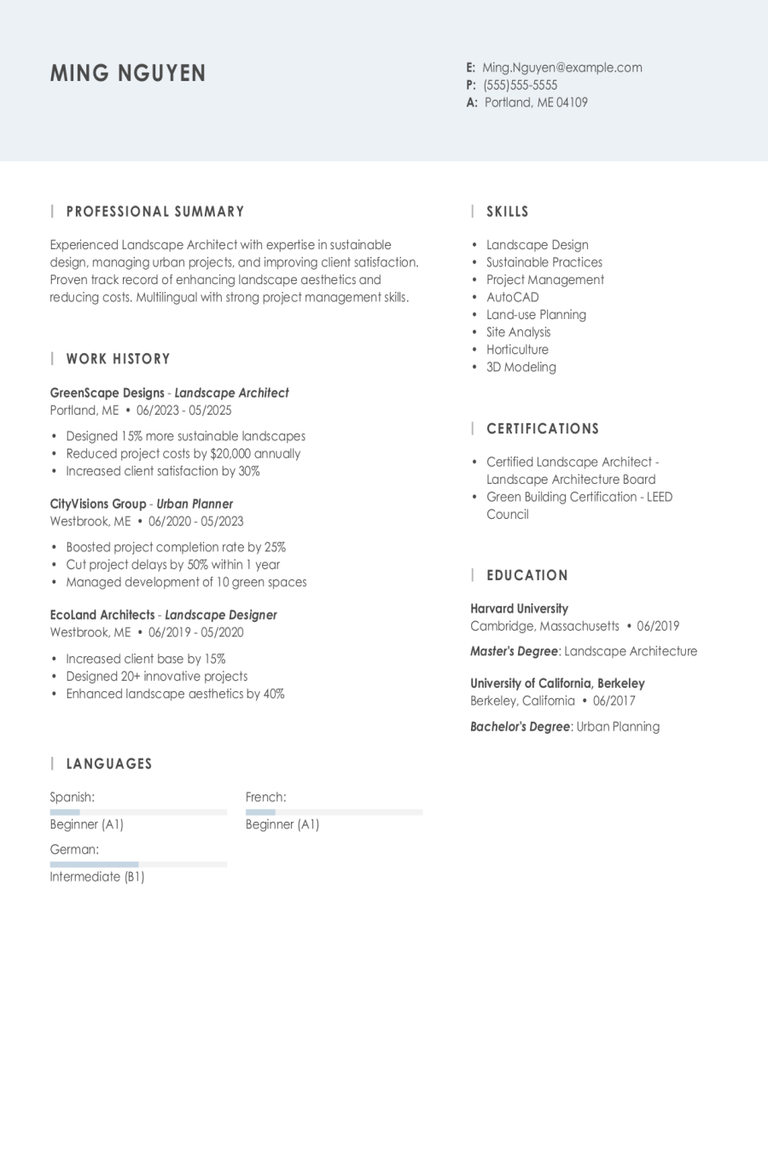
Landscape Architect Resume Examples & Templates for 2025
Explore landscape architect resume examples and tips to learn how to showcase your project management skills and experience with site planning, client collaboration, and sustainable solutions.Build my resumeImport existing resumeCustomize
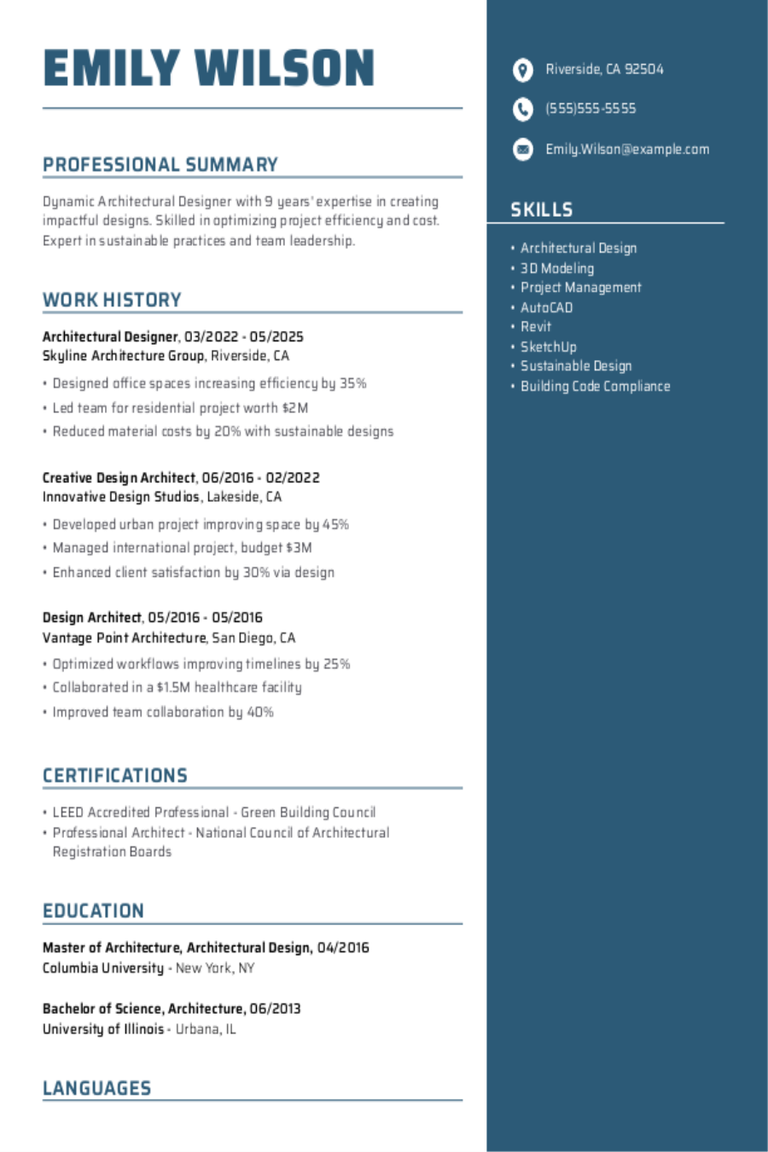
Architectural Designer Resume Examples & Templates for 2025
Explore architectural designer resume examples that show how to highlight your creativity, technical skills, and experience with design software.Build my resumeImport existing resumeCustomize this templateWhy this resume worksQuantifies accomplishments: The applicant’s
